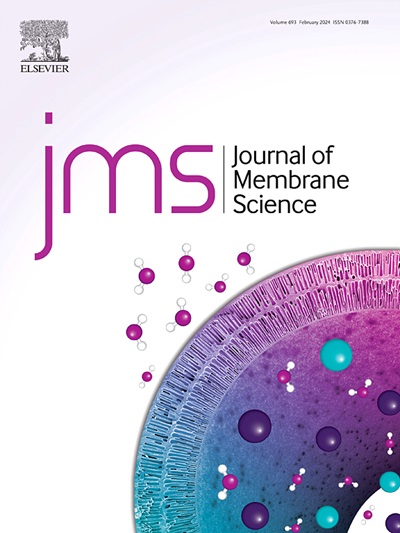正向渗透系统中多组分水分和养分运移的动态计算
IF 8.4
1区 工程技术
Q1 ENGINEERING, CHEMICAL
引用次数: 0
摘要
随着水产养殖生产在全球范围内获得更多的兴趣,水产养殖废水的产量将继续上升。由于废水中存在稀释的营养物(NH4+和H2PO4−),所述营养物的回收需要脱水过程。正渗透(FO)系统具有较低的污染倾向和较高的重复利用效率,是一种很好的脱水工艺。因此,需要一种多分量FO系统的性能仿真方法。多组分菲氏溶液-扩散模型为含3个以上离子的FO体系提供了一种简便的计算方法。初步的实验研究表明,NH4+在FO膜上的传输依赖于自扩散和诱导扩散。对于H2PO4 -离子,传输主要是对流,H2PO4 -离子在FO膜上的扩散与水通量的增加呈正相关。通过两个单独的实验对估计参数进行了实验验证。计算了FO系统的水通量、反盐通量、养分截除率和最终养分浓度等性能,并与实验数据进行了比较。比较表明,计算值的偏差一般在6%以内,个别异常值偏差在9%以内。动态计算显示了估计参数的灵活性,因为它还可以预测更长的运行周期和更高的初始进料和抽液体积下的FO系统性能。本文章由计算机程序翻译,如有差异,请以英文原文为准。

Dynamic computation of multicomponent water and nutrients transport in forward osmosis system
As aquaculture production garners more interest around the globe, the production of aquaculture effluent will continue to rise. With the presence of dilute nutrients (NH4+ and H2PO4−) in the effluent, the recovery of said nutrients requires a dewatering process. Forward osmosis (FO) systems are good dewatering processes as they have low fouling tendencies and better reuse efficiency. With that, a method for performance simulation is required for multicomponent FO systems. Multicomponent Fickian solution-diffusion model provides a simple computation method for FO systems containing more than three ions. Preliminary experimental studies concluded that NH4+ transport across FO membrane relies on self-diffusion and induced diffusion caused by draw solute (Mg2+). For H2PO4− ions, the transport was mainly contributed by convection as the diffusion of H2PO4− across FO membrane showed positive relation with increasing water flux. Experimental validation of estimated parameters was also performed by two separate experiments. FO system performance such as water flux, reverse salt flux, nutrient rejection, and final nutrient concentration was computed and compared with experimental data. The comparison showed that the values computed were generally within 6 % of deviation with some outliers at 9 % of deviation. Dynamic computation showed the flexibility of estimated parameters as it can also predict FO system performance that operates at longer operation period and a at a higher initial volume of feed and draw solution.
求助全文
通过发布文献求助,成功后即可免费获取论文全文。
去求助
来源期刊

Journal of Membrane Science
工程技术-高分子科学
CiteScore
17.10
自引率
17.90%
发文量
1031
审稿时长
2.5 months
期刊介绍:
The Journal of Membrane Science is a publication that focuses on membrane systems and is aimed at academic and industrial chemists, chemical engineers, materials scientists, and membranologists. It publishes original research and reviews on various aspects of membrane transport, membrane formation/structure, fouling, module/process design, and processes/applications. The journal primarily focuses on the structure, function, and performance of non-biological membranes but also includes papers that relate to biological membranes. The Journal of Membrane Science publishes Full Text Papers, State-of-the-Art Reviews, Letters to the Editor, and Perspectives.
 求助内容:
求助内容: 应助结果提醒方式:
应助结果提醒方式:


